Sean Bell
Jack
Movie Gen: A Cast of Media Foundation Models
Oct 17, 2024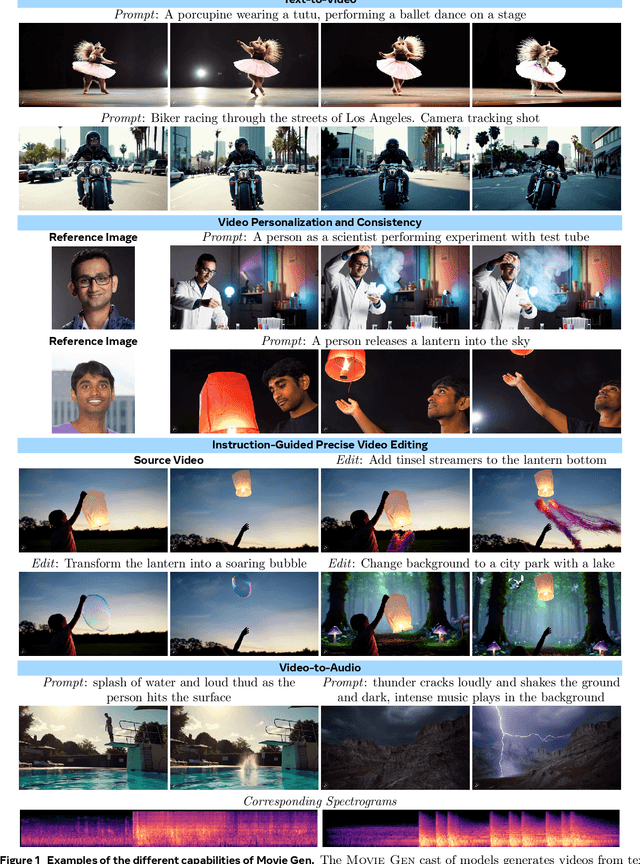

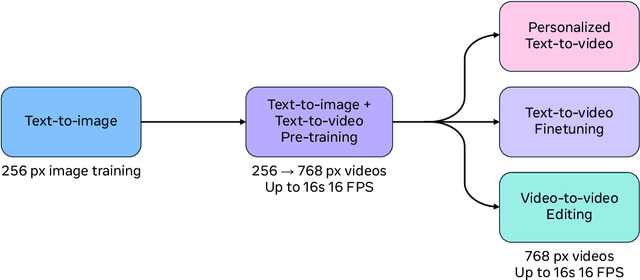
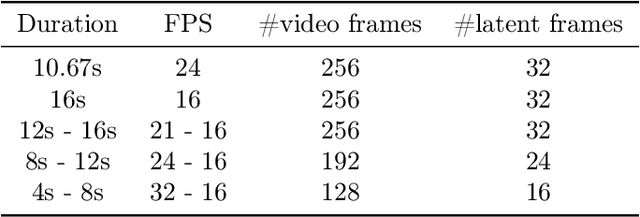
Abstract:We present Movie Gen, a cast of foundation models that generates high-quality, 1080p HD videos with different aspect ratios and synchronized audio. We also show additional capabilities such as precise instruction-based video editing and generation of personalized videos based on a user's image. Our models set a new state-of-the-art on multiple tasks: text-to-video synthesis, video personalization, video editing, video-to-audio generation, and text-to-audio generation. Our largest video generation model is a 30B parameter transformer trained with a maximum context length of 73K video tokens, corresponding to a generated video of 16 seconds at 16 frames-per-second. We show multiple technical innovations and simplifications on the architecture, latent spaces, training objectives and recipes, data curation, evaluation protocols, parallelization techniques, and inference optimizations that allow us to reap the benefits of scaling pre-training data, model size, and training compute for training large scale media generation models. We hope this paper helps the research community to accelerate progress and innovation in media generation models. All videos from this paper are available at https://go.fb.me/MovieGenResearchVideos.
The Llama 3 Herd of Models
Jul 31, 2024Abstract:Modern artificial intelligence (AI) systems are powered by foundation models. This paper presents a new set of foundation models, called Llama 3. It is a herd of language models that natively support multilinguality, coding, reasoning, and tool usage. Our largest model is a dense Transformer with 405B parameters and a context window of up to 128K tokens. This paper presents an extensive empirical evaluation of Llama 3. We find that Llama 3 delivers comparable quality to leading language models such as GPT-4 on a plethora of tasks. We publicly release Llama 3, including pre-trained and post-trained versions of the 405B parameter language model and our Llama Guard 3 model for input and output safety. The paper also presents the results of experiments in which we integrate image, video, and speech capabilities into Llama 3 via a compositional approach. We observe this approach performs competitively with the state-of-the-art on image, video, and speech recognition tasks. The resulting models are not yet being broadly released as they are still under development.
Learning and Verification of Task Structure in Instructional Videos
Mar 23, 2023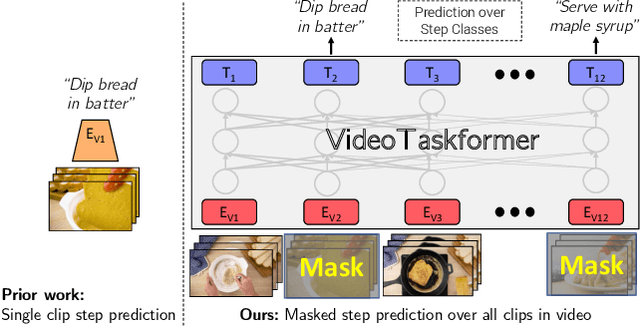
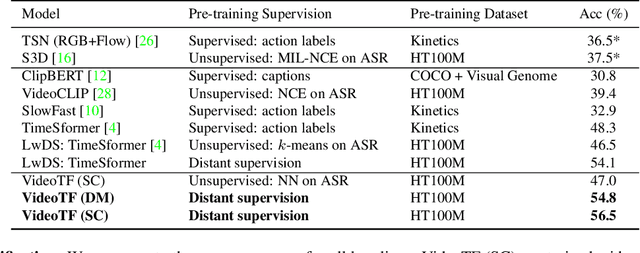
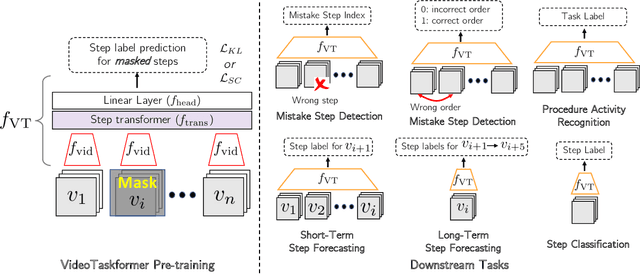
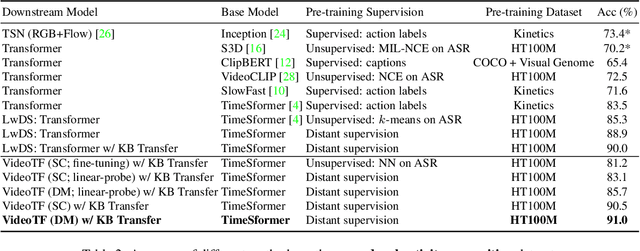
Abstract:Given the enormous number of instructional videos available online, learning a diverse array of multi-step task models from videos is an appealing goal. We introduce a new pre-trained video model, VideoTaskformer, focused on representing the semantics and structure of instructional videos. We pre-train VideoTaskformer using a simple and effective objective: predicting weakly supervised textual labels for steps that are randomly masked out from an instructional video (masked step modeling). Compared to prior work which learns step representations locally, our approach involves learning them globally, leveraging video of the entire surrounding task as context. From these learned representations, we can verify if an unseen video correctly executes a given task, as well as forecast which steps are likely to be taken after a given step. We introduce two new benchmarks for detecting mistakes in instructional videos, to verify if there is an anomalous step and if steps are executed in the right order. We also introduce a long-term forecasting benchmark, where the goal is to predict long-range future steps from a given step. Our method outperforms previous baselines on these tasks, and we believe the tasks will be a valuable way for the community to measure the quality of step representations. Additionally, we evaluate VideoTaskformer on 3 existing benchmarks -- procedural activity recognition, step classification, and step forecasting -- and demonstrate on each that our method outperforms existing baselines and achieves new state-of-the-art performance.
RoPAWS: Robust Semi-supervised Representation Learning from Uncurated Data
Feb 28, 2023
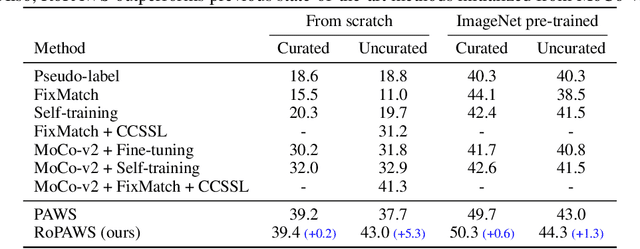


Abstract:Semi-supervised learning aims to train a model using limited labels. State-of-the-art semi-supervised methods for image classification such as PAWS rely on self-supervised representations learned with large-scale unlabeled but curated data. However, PAWS is often less effective when using real-world unlabeled data that is uncurated, e.g., contains out-of-class data. We propose RoPAWS, a robust extension of PAWS that can work with real-world unlabeled data. We first reinterpret PAWS as a generative classifier that models densities using kernel density estimation. From this probabilistic perspective, we calibrate its prediction based on the densities of labeled and unlabeled data, which leads to a simple closed-form solution from the Bayes' rule. We demonstrate that RoPAWS significantly improves PAWS for uncurated Semi-iNat by +5.3% and curated ImageNet by +0.4%.
Tell Me What Happened: Unifying Text-guided Video Completion via Multimodal Masked Video Generation
Nov 23, 2022Abstract:Generating a video given the first several static frames is challenging as it anticipates reasonable future frames with temporal coherence. Besides video prediction, the ability to rewind from the last frame or infilling between the head and tail is also crucial, but they have rarely been explored for video completion. Since there could be different outcomes from the hints of just a few frames, a system that can follow natural language to perform video completion may significantly improve controllability. Inspired by this, we introduce a novel task, text-guided video completion (TVC), which requests the model to generate a video from partial frames guided by an instruction. We then propose Multimodal Masked Video Generation (MMVG) to address this TVC task. During training, MMVG discretizes the video frames into visual tokens and masks most of them to perform video completion from any time point. At inference time, a single MMVG model can address all 3 cases of TVC, including video prediction, rewind, and infilling, by applying corresponding masking conditions. We evaluate MMVG in various video scenarios, including egocentric, animation, and gaming. Extensive experimental results indicate that MMVG is effective in generating high-quality visual appearances with text guidance for TVC.
Shading Annotations in the Wild
May 02, 2017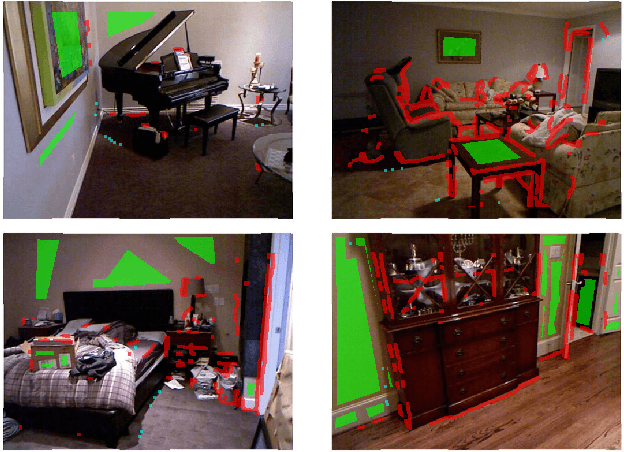
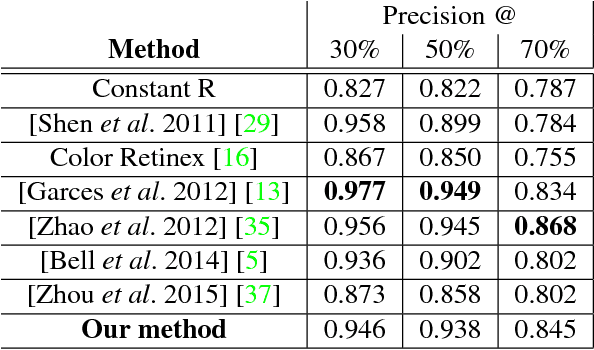
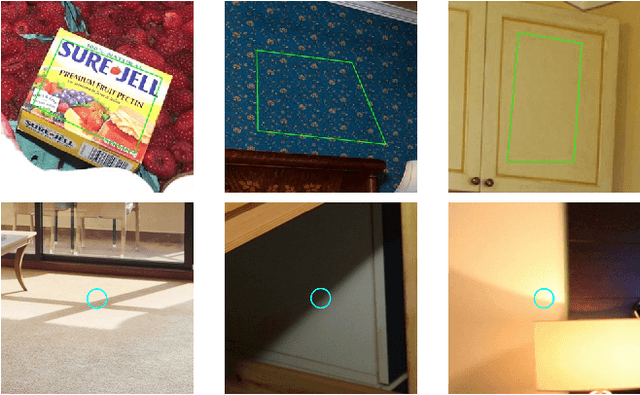
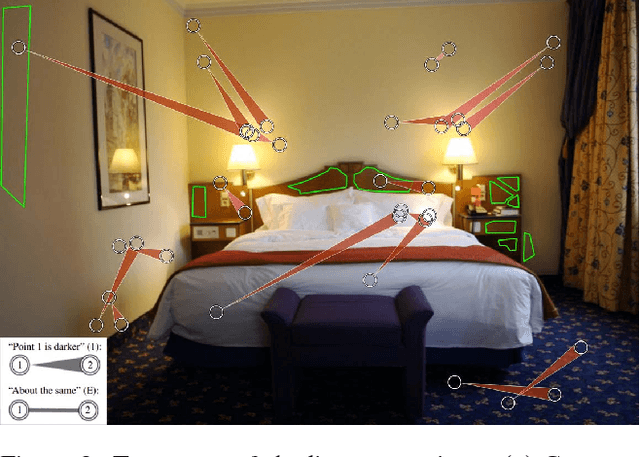
Abstract:Understanding shading effects in images is critical for a variety of vision and graphics problems, including intrinsic image decomposition, shadow removal, image relighting, and inverse rendering. As is the case with other vision tasks, machine learning is a promising approach to understanding shading - but there is little ground truth shading data available for real-world images. We introduce Shading Annotations in the Wild (SAW), a new large-scale, public dataset of shading annotations in indoor scenes, comprised of multiple forms of shading judgments obtained via crowdsourcing, along with shading annotations automatically generated from RGB-D imagery. We use this data to train a convolutional neural network to predict per-pixel shading information in an image. We demonstrate the value of our data and network in an application to intrinsic images, where we can reduce decomposition artifacts produced by existing algorithms. Our database is available at http://opensurfaces.cs.cornell.edu/saw/.
Inside-Outside Net: Detecting Objects in Context with Skip Pooling and Recurrent Neural Networks
Dec 14, 2015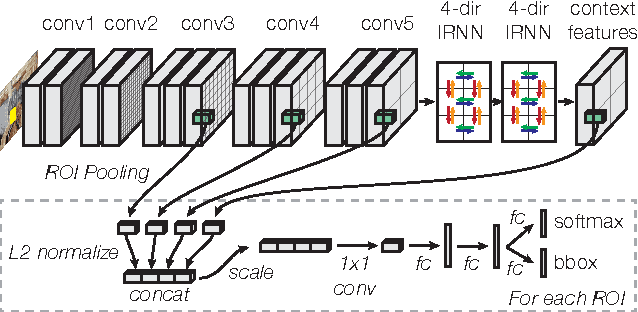



Abstract:It is well known that contextual and multi-scale representations are important for accurate visual recognition. In this paper we present the Inside-Outside Net (ION), an object detector that exploits information both inside and outside the region of interest. Contextual information outside the region of interest is integrated using spatial recurrent neural networks. Inside, we use skip pooling to extract information at multiple scales and levels of abstraction. Through extensive experiments we evaluate the design space and provide readers with an overview of what tricks of the trade are important. ION improves state-of-the-art on PASCAL VOC 2012 object detection from 73.9% to 76.4% mAP. On the new and more challenging MS COCO dataset, we improve state-of-art-the from 19.7% to 33.1% mAP. In the 2015 MS COCO Detection Challenge, our ION model won the Best Student Entry and finished 3rd place overall. As intuition suggests, our detection results provide strong evidence that context and multi-scale representations improve small object detection.
Learning Visual Clothing Style with Heterogeneous Dyadic Co-occurrences
Sep 24, 2015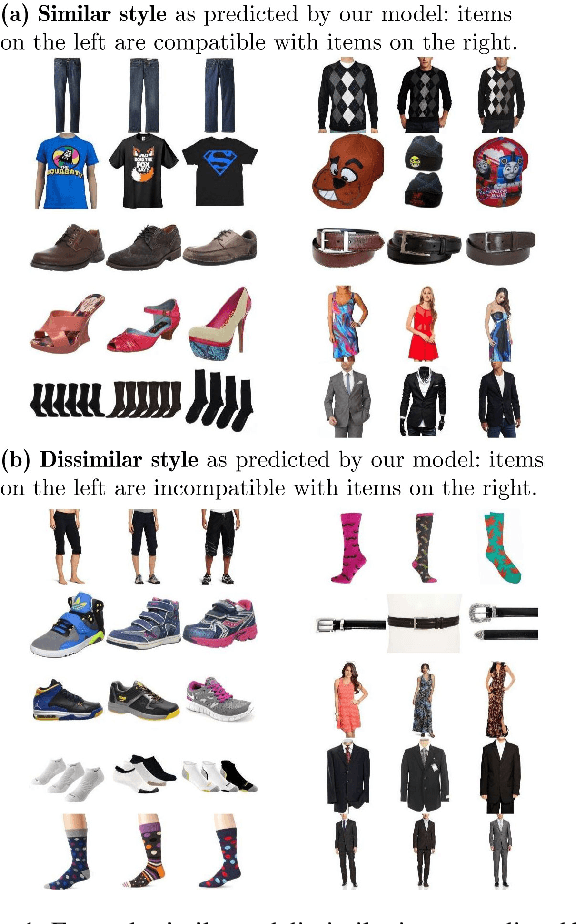
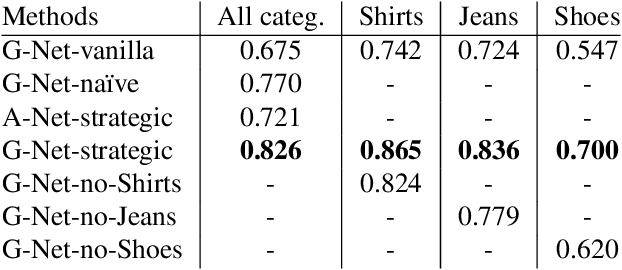

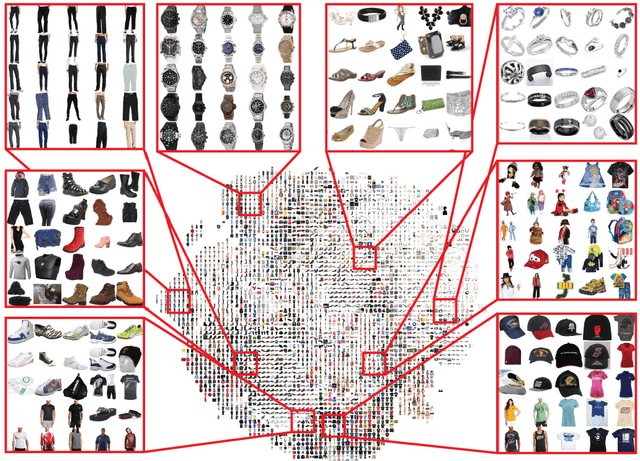
Abstract:With the rapid proliferation of smart mobile devices, users now take millions of photos every day. These include large numbers of clothing and accessory images. We would like to answer questions like `What outfit goes well with this pair of shoes?' To answer these types of questions, one has to go beyond learning visual similarity and learn a visual notion of compatibility across categories. In this paper, we propose a novel learning framework to help answer these types of questions. The main idea of this framework is to learn a feature transformation from images of items into a latent space that expresses compatibility. For the feature transformation, we use a Siamese Convolutional Neural Network (CNN) architecture, where training examples are pairs of items that are either compatible or incompatible. We model compatibility based on co-occurrence in large-scale user behavior data; in particular co-purchase data from Amazon.com. To learn cross-category fit, we introduce a strategic method to sample training data, where pairs of items are heterogeneous dyads, i.e., the two elements of a pair belong to different high-level categories. While this approach is applicable to a wide variety of settings, we focus on the representative problem of learning compatible clothing style. Our results indicate that the proposed framework is capable of learning semantic information about visual style and is able to generate outfits of clothes, with items from different categories, that go well together.
Material Recognition in the Wild with the Materials in Context Database
Apr 14, 2015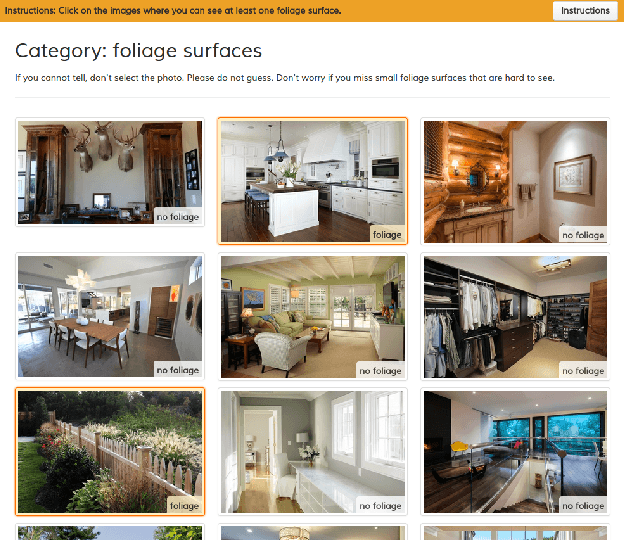
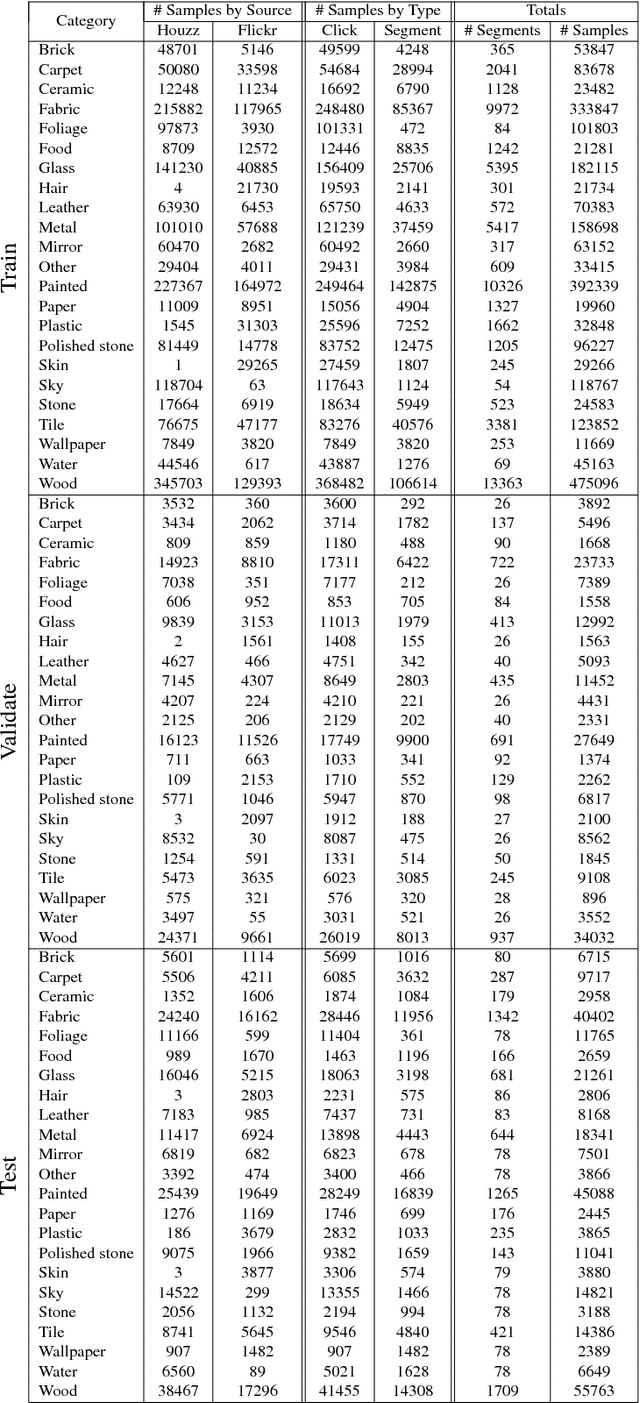
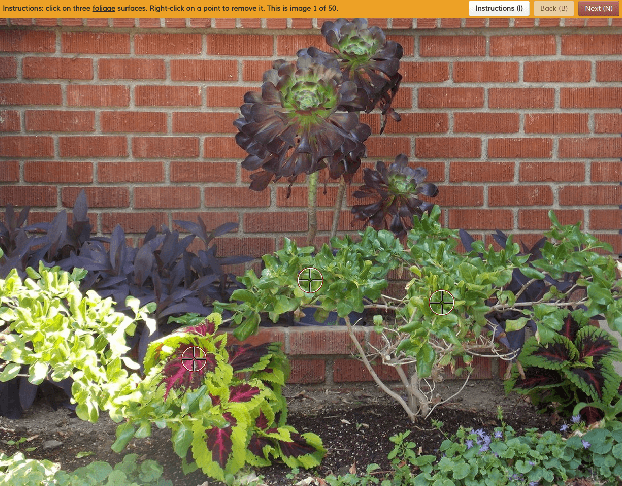

Abstract:Recognizing materials in real-world images is a challenging task. Real-world materials have rich surface texture, geometry, lighting conditions, and clutter, which combine to make the problem particularly difficult. In this paper, we introduce a new, large-scale, open dataset of materials in the wild, the Materials in Context Database (MINC), and combine this dataset with deep learning to achieve material recognition and segmentation of images in the wild. MINC is an order of magnitude larger than previous material databases, while being more diverse and well-sampled across its 23 categories. Using MINC, we train convolutional neural networks (CNNs) for two tasks: classifying materials from patches, and simultaneous material recognition and segmentation in full images. For patch-based classification on MINC we found that the best performing CNN architectures can achieve 85.2% mean class accuracy. We convert these trained CNN classifiers into an efficient fully convolutional framework combined with a fully connected conditional random field (CRF) to predict the material at every pixel in an image, achieving 73.1% mean class accuracy. Our experiments demonstrate that having a large, well-sampled dataset such as MINC is crucial for real-world material recognition and segmentation.
 Add to Chrome
Add to Chrome Add to Firefox
Add to Firefox Add to Edge
Add to Edge